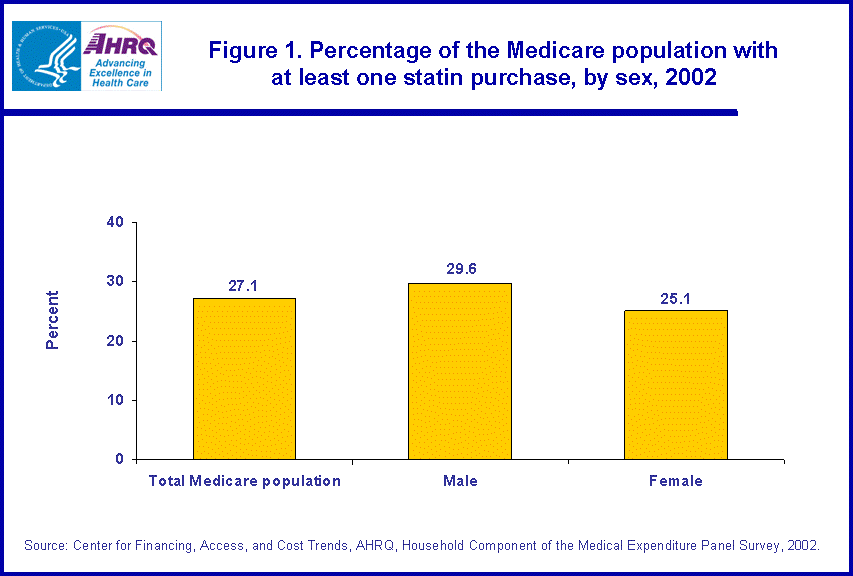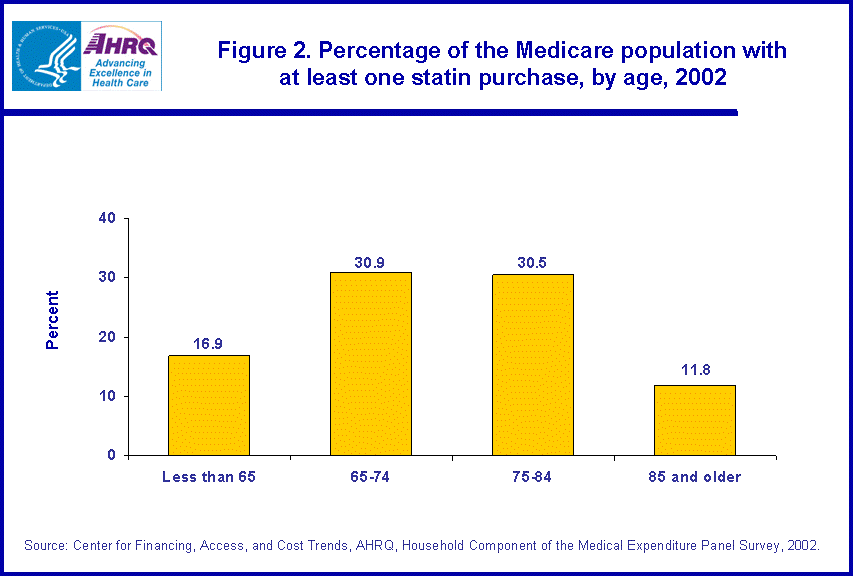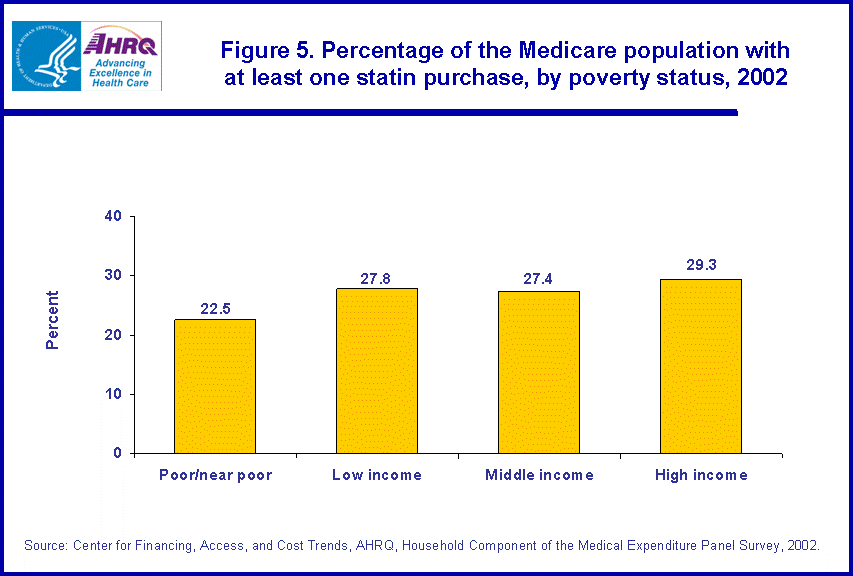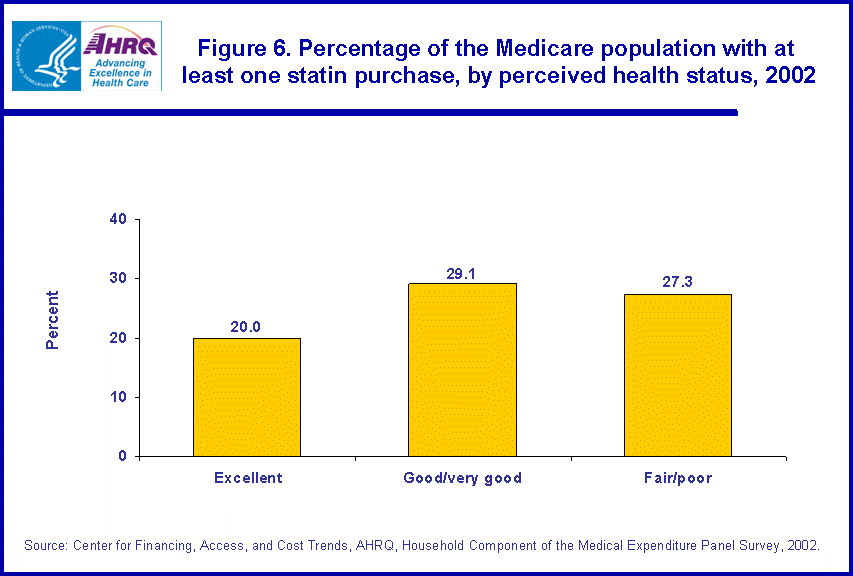
|
|
Font Size:
|
||||
|
|
|
|
||||
STATISTICAL BRIEF #96:
Statin Use in the Civilian Noninstitutionalized Medicare Population in 2002
Highlights
- In 2002, the percentage of male beneficiaries who used a statin (29.6 percent) was higher than for female beneficiaries (25.1 percent).
- About 31 percent of beneficiaries ages 65 to 74 and 75 to 84 used a statin in 2002, which was larger than for beneficiaries who were less than 65 years old (16.9 percent) or beneficiaries who were 85 and older (11.8 percent).
- Among beneficiaries, the percentage of white non-Hispanics using a statin (28.5 percent) was larger than the percentage of black non-Hispanics (20.7 percent) or Hispanics (18.2 percent).
- Across supplementary insurance groups, beneficiaries with private group insurance were the most likely (32.4 percent) and those with public insurance were the least likely (17.4 percent) to use a statin.
- Beneficiaries in very good or good health (29.1 percent) and beneficiaries in fair or poor health (27.3 percent) were both more likely than beneficiaries who reported excellent health (20.0 percent) to have used at least one statin in 2002.
Introduction
Statins are prescribed medications that are used to lower levels of cholesterol and other fats in the blood. This may help prevent medical problems caused by cholesterol clogging the blood vessels.* In 2002, more than a quarter (27.1 percent) of beneficiaries in the civilian noninstitutionalized Medicare population purchased at least one statin during the year. The proportion of beneficiaries using these drugs, however, varied across different socioeconomic and demographic groups within the Medicare population.
This Statistical Brief presents data from the Household Component of the Medical Expenditure Panel Survey (MEPS-HC) on statin use in the civilian noninstitutionalized Medicare population in 2002. Estimates are presented for subgroups of this population defined by sex, age, race/ethnicity, insurance status, poverty status, and health status. All differences discussed in the text are statistically significant at the 0.05 level.
Findings
In 2002, 27.1 percent of the 41.1 million persons in the civilian noninstitutionalized Medicare population used at least one statin during the year. The percentage of males who used statins (29.6 percent) was larger than the percentage for females (25.1 percent). (figure 1)
About 31 percent of beneficiaries ages 65-74 (30.9 percent) and ages 75-84 (30.5 percent) used a statin in 2002. This was larger than the percentage for beneficiaries who were less than 65 years old (16.9 percent) or beneficiaries who were 85 and older (11.8 percent). (figure 2)
In 2002, more than a quarter (28.5 percent) of white non-Hispanic beneficiaries used at least one statin during the year. This was larger than the percentage for black non-Hispanic beneficiaries (20.7 percent) and Hispanic beneficiaries (18.2 percent). The percentage with use for other non-Hispanic beneficiaries (28.1 percent) was larger than the percentage with use for Hispanics. (figure 3)
In 2002, beneficiaries with supplementary private group insurance were the most likely (32.4 percent) and beneficiaries with public insurance in addition to Medicare were the least likely (17.4 percent) to have used a statin during the year. About one-quarter (26.4 percent) of beneficiaries with a private nongroup supplementary policy and one-quarter (25.1 percent) of beneficiaries who were enrolled in a Medicare HMO or had Medicare fee-for-service only used a statin. Beneficiaries in the private nongroup category and in the Medicare HMO/Medicare only category were more likely to use statins than persons with public insurance but less likely to use statins than persons with private group insurance. (figure 4)
Poor and near poor beneficiaries, those with family incomes less than 125 percent of the poverty line, were less likely (22.5 percent) to have used a statin in 2002 than low income (27.8 percent), middle income (27.4 percent), or high income beneficiaries (29.3 percent). (figure 5)
In 2002, beneficiaries who reported excellent health were the least likely (20.0 percent) to use a statin. The proportion with statin use was higher for beneficiaries who reported very good or good health (29.1 percent) and for beneficiaries who reported fair or poor health (27.3 percent). (figure 6)
Data Source
The estimates presented in this Statistical Brief were derived from the 2002 MEPS full-year files and the 2002 MEPS prescribed medicines (PMED) files. Statins were identified by linking the PMED files to the Multum Lexicon. Individuals were classified as using statins if they had one or more purchases of these drugs during the year.
Definitions
Use
Use was defined as one or more purchases of a prescribed statin medicine. The group of drugs commonly known as statins is more formally referred to as 3-hydroxy-3-methylglutaryl coenzyme A (HMG-CoA) reductase inhibitors.* This brief focuses solely on this class of drugs. Other cholesterol-lowering drugs, such as fibric acid derivatives and bile acid sequestraints, were not included. For this brief, statins were determined by using the Multum Lexicon therapeutic classification variables from Cerner Multum, Inc. Statins were defined as those prescribed drugs in the Multum Lexicon therapeutic sub-class, HMG-CoA Reductase Inhibitors.
Medicare population
Individuals were included in the Medicare population if they reported Medicare coverage in at least one month during the year. A small number of persons 65 and older never reported Medicare coverage during the year. These persons were excluded from the analysis.
Age
Age is the last available age for the sampled person. For most persons, this was their age at the end of the year.
Racial and ethnic classifications
Classification by race and ethnicity was based on information reported for each family member. Respondents were asked if each family member's race was best described as American Indian, Alaska Native, Asian or Pacific Islander, black, white, or other. They also were asked if each family member's main national origin or ancestry was Puerto Rican; Cuban; Mexican, Mexicano, Mexican American, or Chicano; other Latin American; or other Spanish. All persons whose main national origin or ancestry was reported in one of these Hispanic groups, regardless of racial background, were classified as Hispanic. Since the Hispanic grouping can include black Hispanic, white Hispanic, Asian and Pacific Islanders Hispanic, and other Hispanic, the race categories of black, white, Asian and Pacific Islanders, and other do not include Hispanic. Beginning in 2002, MEPS respondents were allowed to report multiple races, and these persons were included in the other non-Hispanic category. As a result, there was a slight increase in the percentage of persons classified in this category in 2002 compared with prior years.
Health insurance status
Respondents were asked about health insurance coverage for themselves and all household members at each round of interviewing. The insurance variables reflect supplemental coverage, in addition to Medicare, that beneficiaries had for hospital and physician services. Persons categorized as having supplemental insurance coverage may or may not have coverage for prescription drugs. The insurance categories are mutually exclusive and hierarchical. Persons with more than one type of supplemental coverage were placed into an insurance category in the following order:
- Private group insurance: This group includes those who, at any time in the survey year, had group plan coverage for medical or related expenses. It also includes persons who were covered by CHAMPUS/TRICARE (which covers retired members of the uniformed services and the spouses and children of active-duty military).
- Private non-group: This group includes those who at any time in the survey year had individually purchased private coverage for medical or related expenses. The private group and non-group definitions both include prepaid health plans (such as health maintenance organizations) but exclude extra cash coverage plans, medical benefits linked only to specific diseases (dread disease plans), and casualty benefit plans (such as automobile insurance).
- Other public insurance: This group includes those who at any time in the survey year had coverage from Medicaid or other State and local medical assistance programs.
- Medicare HMO/Medicare only: This group includes persons who did not report any private or public supplemental insurance coverage and were enrolled in Medicare HMOs or had Medicare fee-for-service coverage only.
Each year, persons were classified according to their family's income in terms of poverty status. In this report, poverty status is the ratio of the family's income to the Federal poverty thresholds, which control for the size of the family and the age of the head of the family. The following classification of poverty status was used:
- Poor/near poor: Persons in families with income of 125 percent of the poverty line or less, including those who reported negative income.
- Low income: Persons in families with income from over 125 percent through 200 percent of the poverty line.
- Middle income: Persons in families with income from over 200 percent through 400 percent of the poverty line.
- High income: Persons in families with income over 400 percent of the poverty line.
During each round of interviewing, the household respondent was asked to rate the health of each person in the family according to the following categories: excellent, very good, good, fair, or poor. For this report, the response categories "very good" and "good" were collapsed, as were "fair" and "poor." Health status was missing for approximately 1 percent of beneficiaries.
About MEPS-HC
MEPS-HC is a nationally representative longitudinal survey that collects detailed information on health care utilization and expenditures, health insurance, and health status, as well as a wide variety of social, demographic, and economic characteristics for the civilian noninstitutionalized population. It is cosponsored by the Agency for Healthcare Research and Quality and the National Center for Health Statistics.
For more information about MEPS, call the MEPS information coordinator at AHRQ (301-427-1656) or visit the MEPS Web site at http://www.meps.ahrq.gov/.
References
For a detailed description of the MEPS survey design, sample design, and methods used to minimize sources of nonsampling error, see the following publications:
Cohen, J. Design and Methods of the Medical Expenditure Panel Survey Household Component. MEPS Methodology Report No. 1. AHCPR Pub. No. 97-0026. Rockville, Md.: Agency for Health Care Policy and Research, 1997.
Cohen, S. Sample Design of the 1996 Medical Expenditure Panel Survey Household Component. MEPS Methodology Report No. 2. AHCPR Pub. No. 97-0027. Rockville, Md.: Agency for Health Care Policy and Research, 1997.
Cohen, S. Design Strategies and Innovations in the Medical Expenditure Panel Survey. Medical Care, July 2003: 41(7) Supplement: III-5-III-12.
Suggested Citation
Miller, G. E. and Stagnitti, M. N. Statin Use in the Civilian Noninstitutionalized Medicare Population in 2002. Statistical Brief #96. September 2005. Agency for Healthcare Research and Quality, Rockville, Md. http://meps.ahrq.gov/mepsweb/data_files/publications/st96/stat96.shtml
AHRQ welcomes questions and comments from readers of this publication who are interested in obtaining more information about access, cost, use, financing, and quality of health care in the United States. We also invite you to tell us how you are using this Statistical Brief and other MEPS data and tools and to share suggestions on how MEPS products might be enhanced to further meet your needs. Please e-mail us at mepspd@ahrq.gov or send a letter to the address below:
Steven B. Cohen, PhD
Director
Center for Financing, Access, and Cost Trends
Agency for Healthcare Research and Quality
540 Gaither Road
Rockville, MD 20850
Footnotes
* Medline Plus http://www.nlm.nih.gov/medlineplus/druginfo/uspdi/202284.html
 |
||||||||||||||||||||
|
||||||||||||||||||||
|
|
||||||||||||||||||||
 |
||||||||||||||||||||
|
||||||||||||||||||||
|
|
||||||||||||||||||||
 |
||||||||||||||||||||
|
||||||||||||||||||||
|
|
||||||||||||||||||||
 |
||||||||||||||||||||
|
||||||||||||||||||||
|
|
||||||||||||||||||||
 |
||||||||||||||||||||
|
||||||||||||||||||||
|
|
||||||||||||||||||||
 |
||||||||||||||||||||
|
||||||||||||||||||||
|
|
||||||||||||||||||||


